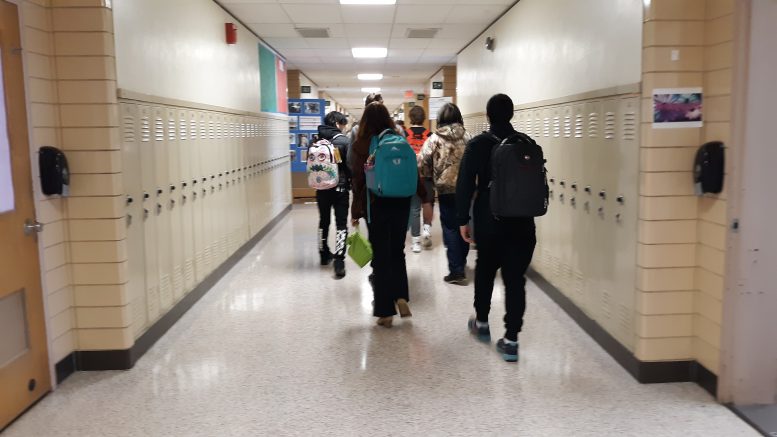By JAN McLAUGHLIN
BG Independent News
A survey of more than 9,000 students in Wood County shows that they are engaging less often in substance abuse, and more often reporting good mental health.
To the pleasant surprise of local educators, mental health and public health officials, it appears that students stopped or never started some bad habits during COVID-19. And even better, they didn’t bounce back to those risky behaviors once the worst of the pandemic ended.
The results of the 2024 Youth Survey on Addiction and Mental Health were presented to local professionals whose job it is to care for kids. Over the past 20 years, the survey has been conducted every two years among local fifth graders through seniors in publicly funded schools throughout the county.
“We have some of the best trend data in Ohio,” said Kyle Clark, of the Wood County Educational Service Center. That data has helped the county secure up to $12 million in federal grants to help with youth addiction and mental health services, he said.

“We are looking at the best results in 20 years,” said Dr. Bill Ivoska, who leads the survey process.
The good news in the study included:
- Many adolescents, who stopped substance abuse during COVID-19 school closures, continued lower drug and alcohol use after the height of the pandemic.
- Adolescents reversed the trend of the previous increase in mental health issues.
- The only substances that kids are using more frequently are caffeinated energy drinks.
However, at the same time, the pandemic may have contributed to other bad behaiors, such as:
- Reports of bullying, especially among kids in grades 5 through 9 continue to trend upwards, especially for cyber and verbal bullying.
- Youth reported a dramatic increase in gaming activity over the past two years, a trend that began during the pandemic. Fifth and sixth graders reported the highest rates, with 42% reporting gaming two hours or more every day.
- Gambling within games increased dramatically.
Ivoska listed several factors that could be contributing to a decline in substance abuse. Fewer students initiated use during the pandemic, increasing peer and parental disapproval, reduced access, greater fear of accidental death, new school policies, aggressive prevention education and intervention services, and community awareness.
Following are more details from the youth survey that is funded by the Wood County Alcohol, Drug Addiction and Mental Health Services Board and conducted by the Wood County Educational Service Center.
This year, the survey was conducted online, which produced a higher response rate than the pencil and paper protocol in past ADAMHS youth studies.
Drug and alcohol use
The reported use for almost all substances increased between 2018 and 2020 (pre-pandemic). Substance use then decreased dramatically between 2020 and 2022, after the onset of the COVID-19 school closures in Wood County and increases in social distancing.
The data further illustrates the trend in declining substance use, with Wood County youth reporting the lowest levels of substance use in the 20-year history of the survey. After two years of returning to school, teen drug use did not rebound to pre-pandemic levels. Research has shown that delays in the onset of substance use among teens can lower trajectories of rates in the future.
To try to weed out fake responses, students who reported using a fake drug were excluded from the analysis. Students who did not complete at least 70% of the survey were excluded. Students who reported using all drugs at all times in the maximum amounts were excluded from the survey. A total of 9,322 surveys were collected and 341 surveys were excluded.
Smoking among local youth took a nosedive, according to the surveys. Twenty years ago, approximately 27% of seniors smoked. Last year, that number had plummeted to 1.6%.
“This is amazing to me,” Ivoska said. Of course, some of them “just converted from a cigarette to a cartridge” for vaping.
While vaping remains the most common method of nicotine consumption among adolescents, the share of students who report vaping nicotine within the past 30 days dropped significantly, from 6.1% of eighth graders in 2020 to 3.4% in 2024; from 15.1% to 5.7% among 10th graders, and from 22.2% to 8.1% among 12th graders.
Alcohol remains the substance with the highest use, but even 30-day alcohol use has declined dramatically, from 7.6% of eighth graders in 2020 to 3% in 2024; from 16.5% to 8.2% among 10th graders, and from 26.6% to 15.7% among 12th graders. Over the past 20 years (from 2004 to 2024), 30-day alcohol use among 12th graders decreased from 47% in 2004 to 15.7% in 2024.
Following is a comparison of substance abuse numbers for Wood County seniors in 2004 to those in 2024:
- Alcohol (any use), from 70% to 30%
- Marijuana, from 35% to 15%
- Cigarettes, from 27% to 1.6%
- Nicotine vapes, from 27% to 8%
- Painkillers, from 22% to 1%
- Cocaine, from 6% to 0.6%
- Barbiturates, from 12% to 1.5%
- Methylphenidate, from 10% to 0.7%
- Ecstasy, from 3.5% to 0.2%
- Inhalants, from 4% to 0.3%
- LSD, from 5% to 1%
“That’s what we’re celebrating today,” Ivoska said about the drops in substance usage.
Mental health issues
The ADAMHS Youth Survey also follows trends in adolescent mental health, bullying, suicide, family dysfunction (ACES) and gaming and gambling.
The 2024 results among Wood County adolescents showed a reversal of the growing increases in mental health issues that began around 2018 in the pre-pandemic period. In 2024 teens reporting “no problems” on the Problem Severity Index increased from 47% (in 2022) to 50%, while teens reporting severe and intense mental health issues decreased from 13% to 10%.
The 2024 results also reflected a reversal of the growing trend in teen suicide ideation and attempts. Rates had been increasing nearly every year over the past decade. While rates have not returned to their lowest levels, they dramatically declined in 2024.
Staff at the Wood County Educational Service Center believe the improvements in mental health may have resulted from a combination of initiatives including: ODE’s mandates for PBIS and SEL which are now being implemented in local schools; stepped up prevention and intervention programming from counselors and prevention staff; from constant education and awareness; and from students finding structure in the return to extracurricular activities and social engagement.
Abuse and neglect
Teens also reported lower rates of adverse childhood experiences that relate to abuse and neglect. For example, when asked if they experienced emotional or physical neglect, rates dropped significantly, from 21.7% for emotional neglect in 2022 to 14.7% in 2024; and from 5.9% to 4.2% for physical neglect.
Rates for physical, emotional, and sexual abuse also declined. Rates for family dysfunction remained the same (parents suffering from mental illness, substance abuse or marital dysfunction).
On the other hand, reports of bullying, especially among teens in grades 5 through 9 continue to trend upwards, especially for cyber and verbal bullying.
Gaming and gambling activity
Youth reported a dramatic increase in gaming activity over the past two years, a trend that began in the pandemic. Fifth and sixth graders reported the highest rates (42% report gaming two hours or more every day).
Gaming activity is any gaming-related activity that has been played either from a computer/laptop, from a gaming console, or from any other kind of device (phone, tablet) on or offline.
Gambling within games increased dramatically. Youth reported a doubling in the purchase of “mystery boxes” or of using currency (apex coins or jewels) within the game. In 2022, about 19% of teens reported buying mystery boxes, but the rate jumped to 40% in 2024. Fantasy and daily fantasy sports betting also increased among 11th and 12th grade males, but other forms of gambling (buying lotto tickets or scratch-offs) declined slightly.
High school junior and senior males reported increases in sports betting via participation in fantasy sports teams or in daily fantasy sports. Approximately 15% of these males reportedly downloaded sports betting apps (which became legal in Ohio in 2023) and 13% reportedly had a 21-year-old place a bet for them.
Additional findings are available in the large publication “The Wood County Youth Survey, 2024” which may be found on the Wood County ESC website: https://www.wcesc.org/programs-and-services/prevention-education/publications/

